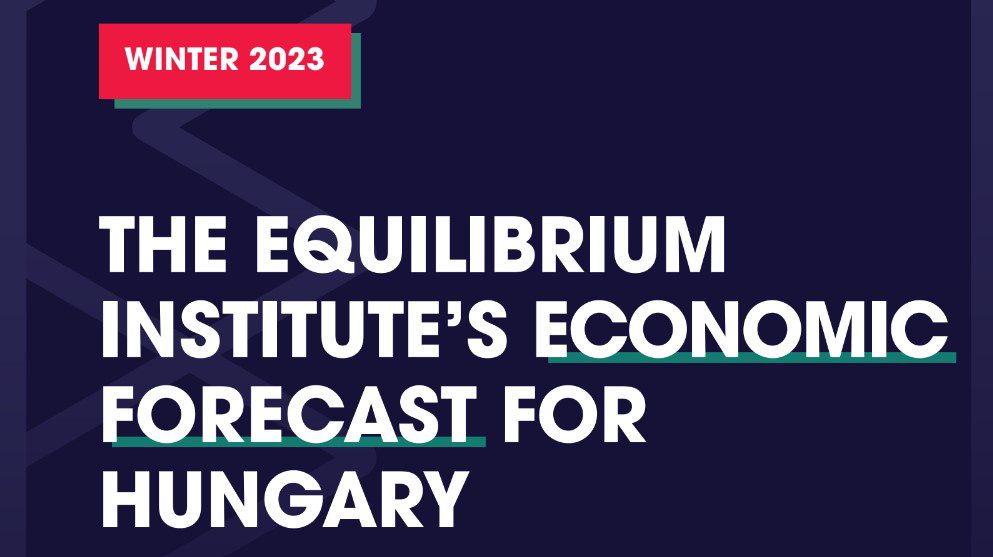The Equilibrium Institute anticipates a significant slowdown in inflation, a resumption of growth next year following this year’s 0.6 percent GDP decrease, and a gradual depreciation of the forint-euro exchange rate. Despite four consecutive quarters of GDP decline, the labor market remains extremely tight. Employment in the private sector is expected to increase this year, and dynamic real wage growth can be expected again in the coming years. The budget deficit will probably remain above three percent next year, instead of the 2.9 percent assumed by the government.
According to the Equilibrium Institute’s forecast, Hungarian GDP will decrease by 0.6 percent in 2023. The think tank expects growth to resume in the following years, with GDP growth reaching 3.2 percent in 2024 and 3.1 percent in 2025. Rebounding consumption and investments could drive the growth of the Hungarian economy.
As per the think tank’s forecast, inflationary pressure is expected to ease in the coming years. Based on currently observable processes, both demand and supply factors tend to point towards a further deceleration in inflation in the coming year. While the average price increase in 2023 will be 17.5 percent, inflation is expected to decrease to 5.7 percent in 2024 and then to 3.6 percent in 2025. High oil prices due to geopolitical uncertainties and rising excise duty will continue to contribute positively to price increases. However, in 2024, a lower price increase than general inflation for food is expected. The central bank may reach its inflation target in the second half of 2025.
The gradual decrease in inflation allows the central bank to reduce the policy interest rate, but the vulnerability of the forint permits only cautious interest rate cuts. The devaluation of the forint will continue, but it will remain more subdued than the dynamics seen in recent years. The average HUF/EUR exchange rate is expected to be in the range of 393-403 in 2024 and 406-419 in 2025.
The declining purchasing power due to high inflation led to a drop in household consumption in 2023, the extent of which was even greater than during the COVID epidemic. However, in the following years, due to the start of the economic cycle and the expected increase in real wages, consumption may once again be on an upward trajectory. After last year’s outstanding increase in consumption, this year, the Equilibrium Institute expects the real value of consumption to decrease by more than 2 percent. However, thanks to disinflationary trends, real wages growth is turning into positive territory, and to the restarting economy, household consumption may return to an upward trajectory in 2024. The Equilibrium Institute expects a real increase in consumption of 2.2 percent next year and 3.5 percent in 2025.
The unexpected drop in consumption put the budget in a difficult situation. In October, the government raised this year’s deficit target, originally planned for 3.5 percent, for the second time, this time to 5.2 percent. At the same time, it is unlikely that the government would start a serious budget adjustment next year, jeopardizing growth. Therefore, the Equilibrium Institute expects a deficit higher than 3 percent in 2024.
Labor market demand showed a high degree of resilience during the past year. Due to economic growth restarting in the third quarter of 2023, the Equilibrium Institute expects a 0.8 percent increase in the number of people employed in the private sector this year, with a similar dynamic in the following years. The unemployment rate in Hungary will be 3.9 percent this year and 3.7 percent next year. In 2023, despite the double-digit nominal wage increase, the purchasing power of wages will decrease by 1.6 percent. Next year, due to tight labor market conditions and the economic recovery, a double-digit nominal wage increase and positive real wage dynamics are expected. The merger of the minimum wage and the graduate minimum wage is likely by the end of 2027. Although a merger at a level above HUF 400,000 (EUR 1050) was also discussed in the press, based on the GDP and inflation forecast of the Equilibrium Institute, a level of HUF 350–370,000 (EUR 920-975) at the end of the four-year period seems more likely.
For our forecast, we considered the data received until October 31, 2023.
The full forecast is available by clicking here.


